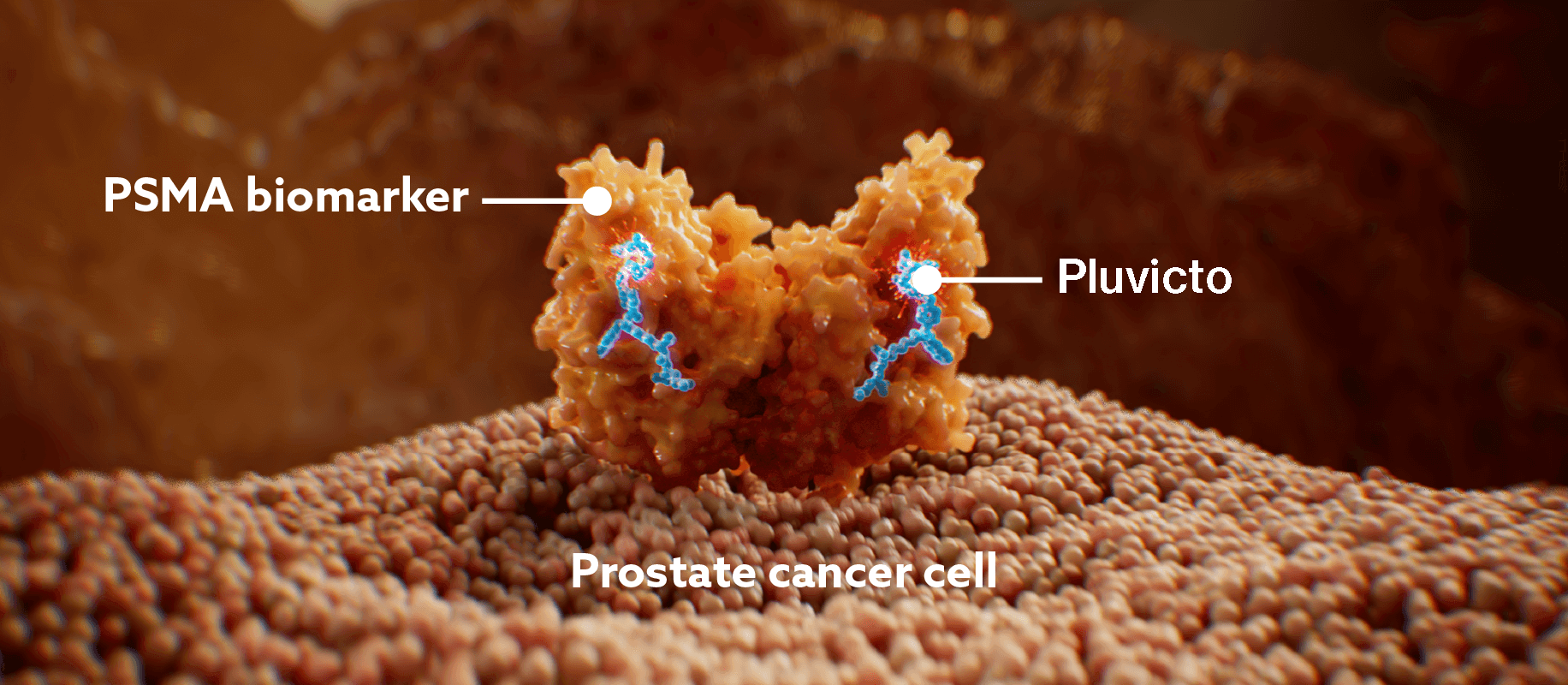Explore RLT services
Our all-encompassing service aims to simplify the RLT journey and minimise time-to-treatment for your eligible patients.
This page is intended for UK healthcare professionals and other relevant decision makers only. If you are a member of the public, please click here.
This portal is funded and owned by Novartis Pharmaceuticals UK Ltd and includes content approved by Novartis.
Adverse events reporting information can be found in the footer of this page.
These links will take you to the electronic medicines compendium (emc) website, which is a non-Novartis website.
Pluvicto®▼ (lutetium [177Lu] vipivotide tetraxetan) is indicated for the treatment of adult patients with prostate-specific membrane antigen (PSMA)-positive metastatic castration-resistant prostate cancer (mCRPC) who have been treated with androgen receptor (AR) pathway inhibition and taxane-based chemotherapy or who are not medically suitable for taxanes.1
Pluvicto is available in the United Kingdom to eligible private patients.
Locametz®▼ (gozetotide) is for diagnostic use only. Locametz, after radiolabelling with gallium-68, is a radioactive diagnostic agent indicated for the identification of prostate-specific membrane antigen (PSMA)-positive lesions by positron emission tomography (PET) in adult patients with prostate cancer.2
Pluvicto is a PSMA-targeted radioligand therapy (RLT) that delivers DNA-damaging radiation to PSMA-positive bone, nodal, and visceral metastases.1,3–7
Pluvicto targets PSMA-positive cells, including prostate cancer cells.1
Pluvicto comprises 2 key components:
lutetium-177, a cytotoxic radionuclide, and PSMA-617, a PSMA-targeting ligand.1
As determined by pre-clinical research, Pluvicto binds with high affinity to PSMA, a transmembrane protein overexpressed on prostate cancer cells.1
After binding to PSMA, Pluvicto undergoes endocytosis and is internalised into the cell.1,3
As determined by preclinical research, Lutetium-177, (the cytotoxic radionuclide of Pluvicto), emits DNA-damaging radiation within the cell.1,3,5
The short path length of the radiation emitted by Pluvicto (approx. 2 mm max.), causes single- and double-stranded DNA breaks in targeted cells as well as surrounding cells, which can lead to cell death.4,5,10
The most common adverse reactions (≥20%) occurring at a higher incidence in patients who received Pluvicto + BSoC were fatigue (43.1%), dry mouth (39.3%), nausea (35.3%), anaemia (31.8%), decreased appetite (21.2%) and constipation (20.2%).1 Clinically relevant adverse reactions in <5% of patients included dry eye, vertigo and pancytopenia (including bicytopenia).1
Please refer to the Pluvicto Summary of Product Characteristics for full safety information.
177Lu, lutetium; ADR, adverse drug reaction; AR, androgen receptor; BSoC, best standard of care; DNA, deoxyribonucleic acid; mCRPC, metastatic castration-resistant prostate cancer; MoA, mechanism of action; PET, positron emission tomography; PSMA, prostate-specific membrane antigen; RLT, radioligand therapy.
References
Pluvicto®▼ (lutetium [177Lu] vipivotide tetraxetan) Summary of Product Characteristics.
Locametz®▼ (gozetotide) Summary of Product Characteristics.
Benešová M, et al. J Nucl Med 2015;56(6):914–920.
Fendler WP, et al. J Nucl Med 2017;58(11):1786–1792.
Hofman MS, et al. Lancet Oncol 2018;19(6):825–833.
Sartor O, et al. N Engl J Med 2021;385(12):1091–1103.
Violet J, et al. J Nucl Med 2019;60(4):517–523.
Liu H, et al. Cancer Res 1998;58(18):4055–4060.
Rajasekaran SA, et al. Mol Biol Cell 2003;14(12):4835–4845.
Ruigrok EAM, et al. Eur J Nucl Med Mol Imaging 2021;48(5):1339–1350.
Maffey-Steffan J, et al. Eur J Nucl Med Mol Imaging 2020;47(3):695–712.
Vlachostergios PJ, et al. Front Oncol 2021;11:630589.
Woythal N, et al. J Nucl Med 2018;59(2):238–243.
Schmuck S, et al. J Nucl Med 2017;58(12):1962–1968.
UK | October 2025 | FA-11470709
Adverse events should be reported. Reporting forms and information can be found at www.mhra.gov.uk/yellowcard. Adverse events should also be reported to Novartis online through the pharmacovigilance intake (PVI) tool at www.novartis.com/report, or alternatively email [email protected] or call 01276 698370.



